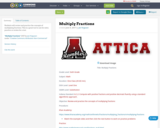
Students will review and practice the concepts of multiplying fractions. This is a great tool to use for extra practice or review for a test.
- Subject:
- Mathematics
- Material Type:
- Activity/Lab
- Date Added:
- 06/09/2017

Students will review and practice the concepts of multiplying fractions. This is a great tool to use for extra practice or review for a test.
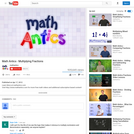
Learn how to multiply fractions, super easy!
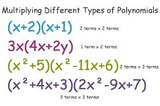
Intro lesson for multipling polynomials. Basic level lesson.
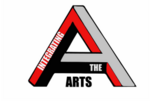
This resource was created by Heidi Meyers, in collaboration with Dawn DeTurk, Hannah Blomstedt, and Julie Albrecht, as part of ESU2's Integrating the Arts project. This project is a four year initiative focused on integrating arts into the core curriculum through teacher education, practice, and coaching.
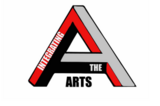
This resource was created by Prairie Compton, in collaboration with Dawn DeTurk, Hannah Blomstedt, and Julie Albrecht, as part of ESU2's Integrating the Arts project. This project is a four year initiative focused on integrating arts into the core curriculum through teacher education, practice, and coaching.
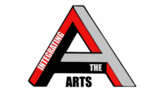
This resource was created by Jennifer Trenhaile, in collaboration with Dawn DeTurk, Hannah Blomstedt, and Julie Albrecht, as part of ESU2's Integrating the Arts project. This project is a four year initiative focused on integrating arts into the core curriculum through teacher education, practice, and coaching.
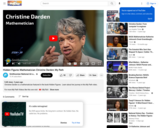
Christine Darden is a mathematician featured in the book Hidden Figures. Learn about her journey in this My Path video.
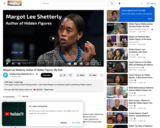
From paper route to award winning author! Learn about Margot Lee Shetterly's path to publishing Hidden Figures.

The ND Academy website (https://NDAcademy.FoxPing.com/) provides links to: 1) Electronics Is Easy? (electronic engineering), 2) Khan Academy (math, science, history, etc.), 3) Boseman Science (chemistry, physics, etc.). 4) Robert's Rules of Order in a Nutshell (efficient, professional meetings), 5) Cochlear Implants (deafness is a more severe handicap than blindness).

The New England Mathematical Association of Two Year Colleges 2021 Virtual Conference.
(Monday, April 5 - Friday, April 16)
Recorded presentations

We will have the students use many travel websites to gather information about New York City. Each website will offer data about pricing, activities, and travel options that the students can choose from. Examples that we gave are Travelocity, Expedia, or the Indianapolis Airport website. Using the different sources could cause a debate about pricing among students. Each website offers different pricing and deals that students can choose.
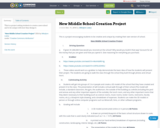
This is a project asking students to create a new school and to be unique with how they design it.
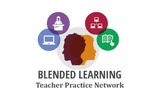
This problem-based learning module is designed to engage students in solving a real problem within the community. The question being “How can I help my community get digitally connected?” Students will choose to investigate one of three solutions of making wifi available in our school district to the most populated areas. They will either choose to put Wifi on bus, placing hotspots in the community or using kajeet. The students will be using Google Earth Pro to place circles on a map and calculating the area of these circles. Students will make a model of these circles onto a hard copy using scale factor. At the conclusion, the students will present findings to administration, the board of education, state and local leaders as well as their peers. These findings can be presented through the choice of a display board, flyer, video production or prezi.This blended module includes teacher-led discussion, group-led investigation and discussions along with technology integration.
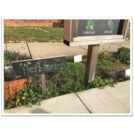
In this lesson the students will be able to demonstrate the ability to use a variety of non-standard unit of measurements to measure the length of different objects around the outdoor classroom.
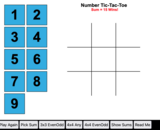
A drag and drop tic-tac-toe game intended for development of elementary school children with basic math skills. Can be used on a smartphone.

Many people are fascinated with ancient Egypt. The amazing, unique culture influenced many other civilizations and cultures. If you study the history of math, you will see how this influence included mathematics. Ancient Egypt also lasted an incredibly long time – over 3000 years. According to Egyptologist Bob Brier, “No civilization lasted so long, contributed so much, or repeatedly amazed as did ancient Egypt.”
In this Open Educational Resource activity, students will have the opportunity to learn about ancient Egyptian numerals and basic arithmetic. For motivation, the setting is a scribal school with each student using a clipboard, paper, and fine point black marker to simulate a board, papyrus, and brush with ink. The activity can also be completed on its own without the scribal school setting.
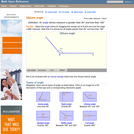
An interactive applet and associated web page that demonstrate obtuse angles (those between 90 and 180 deg). The applet presents an angle (initially obtuse) that the user can adjust by dragging the end points of the line segments forming the angle. As it changes it shows the angle measure and a message that indicate which type of angle it is. There a software 'detents' that make it easy capture exact angles such as 90 degrees and 180 degrees The message and angle measures can be turned off to facilitate classroom discussion. The text on the page has links to other pages defining each angle type in depth. Applet can be enlarged to full screen size for use with a classroom projector. This resource is a component of the Math Open Reference Interactive Geometry textbook project at http://www.mathopenref.com.
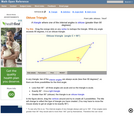
An interactive applet and associated web page that demonstrate the three types of triangle: acute, obtuse and right. The applet shows a triangle that is initially obtuse (one angle greater than 90 degrees) which the user can reshape by dragging any vertex. There is a message changes in real time while the triangle is being dragged that tells if the triangle is an acute, right or obtuse triangle and gives the reason why. By experimenting with the triangle student can develop an intuitive sense of the difference between these three classes of triangle. Applet can be enlarged to full screen size for use with a classroom projector. This resource is a component of the Math Open Reference Interactive Geometry textbook project at http://www.mathopenref.com.
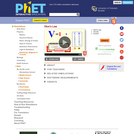
See how the equation form of Ohm's law relates to a simple circuit. Adjust the voltage and resistance, and see the current change according to Ohm's law. The sizes of the symbols in the equation change to match the circuit diagram.

See how the equation form of Ohm's law relates to a simple circuit. Adjust the voltage and resistance, and see the current change according to Ohm's law. The sizes of the symbols in the equation change to match the circuit diagram.